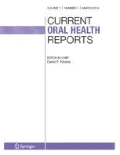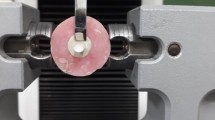Abstract
Newly developed ceramic-reinforced polymers CAD/CAM restorative materials (CRP) represent a viable esthetic material for dental restorations. They can be classified into polymer-infiltrated ceramic (PIC) and resin nano-ceramic (RNC). This review article analyzes the latest scientific findings on wear, fatigue resistance, bonding mechanisms, fracture resistance, and esthetic properties. The literature shows that fatigue resistance of ceramic-reinforced polymers appears to be adequate to survive the masticatory forces. PIC and RNC CAD/CAM blocks have similar fracture toughness, but lower than that of ceramic-based CAD/CAM blocks. The roughness of polished different ceramic-reinforced polymers is comparable; however, aging increases the surface roughness significantly. Different CRPs require a dedicated surface treatment; nonetheless, PIC and RNC are able to attain high bond strengths. The esthetic properties of CRPs are clinically acceptable. Ceramic-reinforced polymers appear to be an ideal material for minimally invasive restorations.
Similar content being viewed by others
References
Papers of particular interest, published recently, have been highlighted as: •• Of major importance
Park S, Quinn JB, Romberg E, Arola D. On the brittleness of enamel and selected dental materials. Dent Mater. 2008;24(11):1477–85.
Gemalmaz D, Kukrer D. In vivo and in vitro evaluation of marginal fit of class II ceromer inlays. J Oral Rehabil. 2006;33(6):436–42.
Cho L, Song H, Koak J, Heo S. Marginal accuracy and fracture strength of ceromer/fiber-reinforced composite crowns: effect of variations in preparation design. J Prosthet Dent. 2002;88(4):388–95.
Ku CW, Park SW, Yang HS. Comparison of the fracture strengths of metal-ceramic crowns and three ceromer crowns. J Prosthet Dent. 2002;88(2):170–5.
Della Bona A, Corazza PH, Zhang Y. Characterization of a polymer-infiltrated ceramic-network material. Dent Mater. 2014;30(5):564–9.
Nguyen JF, Ruse D, Phan AC, Sadoun MJ. High-temperature-pressure polymerized resin-infiltrated ceramic networks. J Dent Res. 2014;93(1):62–7.
Nguyen JF, Migonney V, Ruse ND, Sadoun M. Properties of experimental urethane dimethacrylate-based dental resin composite blocks obtained via thermo-polymerization under high pressure. Dent Mater. 2013;29(5):535–41.
Nguyen JF, Migonney V, Ruse ND, Sadoun M. Resin composite blocks via high-pressure high-temperature polymerization. Dent Mater. 2012;28(5):529–34.
He LH, Swain M. A novel polymer infiltrated ceramic dental material. Dent Mater. 2011;27(6):527–34.
Kassem AS, Atta O, El-Mowafy O. Fatigue resistance and microleakage of CAD/CAM ceramic and composite molar crowns. J Prosthodont. 2012;21(1):28–32.
Magne P, Schlichting LH, Paranhos MP. Risk of onlay fracture during pre-cementation functional occlusal tapping. Dent Mater. 2011;27(9):942–7.
Magne P, Schlichting LH, Maia HP, Baratieri LN. In vitro fatigue resistance of CAD/CAM composite resin and ceramic posterior occlusal veneers. J Prosthet Dent. 2010;104(3):149–57.
Belli R, Geinzer E, Muschweck A, Petschelt A, Lohbauer U. Mechanical fatigue degradation of ceramics versus resin composites for dental restorations. Dent Mater. 2014;30(4):424–32.
Aboushelib MN, Elsafi MH. Survival of resin infiltrated ceramics under influence of fatigue. Dent Mater. 2016;32(4):529–34.
Homaei E, Farhangdoost K, Tsoi JK, Matinlinna JP, Pow EH. Static and fatigue mechanical behavior of three dental CAD/CAM ceramics. J Mech Behav Biomed Mater. 2016;59:304–13.
Chen C, Trindade FZ, de Jager N, Kleverlaan CJ, Feilzer AJ. The fracture resistance of a CAD/CAM Resin Nano Ceramic (RNC) and a CAD ceramic at different thicknesses. Dent Mater. 2014;30(9):954–62.
Ankyu S, Nakamura K, Harada A, et al. Fatigue analysis of computer-aided design/computer-aided manufacturing resin-based composite vs. lithium disilicate glass-ceramic. Eur J Oral Sci 2016.
Quinn GD, Giuseppetti AA, Hoffman KH. Chipping fracture resistance of dental CAD/CAM restorative materials: part I—procedures and results. Dent Mater. 2014;30(5):e99–e111.
Badawy R, El-Mowafy O, Tam LE. Fracture toughness of chairside CAD/CAM materials—alternative loading approach for compact tension test. Dent Mater 2016.
Ornaghi BP, Meier MM, Rosa V, et al. Subcritical crack growth and in vitro lifetime prediction of resin composites with different filler distributions. Dent Mater. 2012;28(9):985–95.
Shah MB, Ferracane JL, Kruzic JJ. R-curve behavior and micromechanisms of fracture in resin based dental restorative composites. J Mech Behav Biomed Mater. 2009;2(5):502–11.
Coldea A, Fischer J, Swain MV, Thiel N. Damage tolerance of indirect restorative materials (including PICN) after simulated bur adjustments. Dent Mater. 2015;31(6):684–94.
Coldea A, Swain MV, Thiel N. Mechanical properties of polymer-infiltrated-ceramic-network materials. Dent Mater. 2013;29(4):419–26. This article evaluates the correlation between ceramic network density, elastic modulus, and hardness of PIC.
Ramos NC, Campos TM, Paz IS, et al. Microstructure characterization and SCG of newly engineered dental ceramics. Dent Mater 2016. http://dx.doi.org/10.1016/j.dental.2016.03.018.
Duarte Jr S, Sartori N, Cascione D, Phark J-H. Biomaterials update: ceramic-reinforced polymers: overview of CAD/CAM hybrid restorative materials. Quintessence Dent Technol. 2014;37:32–48. This review article focuses on physical properties of ceramic-reinforced polymers and their clinical application.
Johnson AC, Versluis A, Tantbirojn D, Ahuja S. Fracture strength of CAD/CAM composite and composite-ceramic occlusal veneers. J Prosthodont Res. 2014;58(2):107–14.
Passos SP, de Freitas AP, Iorgovan G, et al. Enamel wear opposing different surface conditions of different CAD/CAM ceramics. Quintessence Int. 2013;44(10):743–51.
Mormann WH, Stawarczyk B, Ender A, et al. Wear characteristics of current aesthetic dental restorative CAD/CAM materials: two-body wear, gloss retention, roughness and Martens hardness. J Mech Behav Biomed Mater. 2013;20:113–25.
Kunzelmann KH, Jelen B, Mehl A, Hickel R. Wear evaluation of MZ100 compared to ceramic CAD/CAM materials. Int J Comput Dent. 2001;4(3):171–84.
Bayne SC, Taylor DF, Heymann HO. Protection hypothesis for composite wear. Dent Mater. 1992;8(5):305–9.
Oh WS, Delong R, Anusavice KJ. Factors affecting enamel and ceramic wear: a literature review. J Prosthet Dent. 2002;87(4):451–9.
Lawson N, Burgess JO. Biomaterials update: wear of CAD/CAM materials. Quintessence Dent Technol. 2016;39:162–69. This article evaluates the intra-oral wear different chairside CAD/CAM materials.
Kamonkhantikul K, Arksornnukit M, Lauvahutanon S, Takahashi H. Toothbrushing alters the surface roughness and gloss of composite resin CAD/CAM blocks. Dent Mater J. 2016;35(2):225–32.
Ozcan M, Volpato CA. Surface conditioning and bonding protocol for polymer-infiltrated ceramic: how and why? J Adhes Dent. 2016;18(2):174–5. This article evaluates the surface treatment for bonding of PIC.
Loose M, Rosentritt M, Leibrock A, Behr M, Handel G. In vitro study of fracture strength and marginal adaptation of fibre-reinforced-composite versus all ceramic fixed partial dentures. Eur J Prosthodont Restor Dent. 1998;6(2):55–62.
Rodrigues Jr SA, Ferracane JL, Della Bona A. Influence of surface treatments on the bond strength of repaired resin composite restorative materials. Dent Mater. 2009;25(4):442–51.
Wiegand A, Stucki L, Hoffmann R, Attin T, Stawarczyk B. Repairability of CAD/CAM high-density PMMA- and composite-based polymers. Clin Oral Investig. 2015;19(8):2007–13.
Stawarczyk B, Krawczuk A, Ilie N. Tensile bond strength of resin composite repair in vitro using different surface preparation conditionings to an aged CAD/CAM resin nanoceramic. Clin Oral Investig. 2015;19(2):299–308.
Ozcan M, Volpato CA. Surface conditioning and bonding protocol for nanocomposite indirect restorations: how and why? J Adhes Dent. 2016;18(1):82. This article evaluates the adequate surface treatment for bonding of RNC.
Lawson NC, Burgess JO. Gloss and stain resistance of ceramic-polymer CAD/CAM restorative blocks. J Esthet Restor Dent. 2016;28 Suppl 1:S40–5.
Awad D, Stawarczyk B, Liebermann A, Ilie N. Translucency of esthetic dental restorative CAD/CAM materials and composite resins with respect to thickness and surface roughness. J Prosthet Dent. 2015;113(6):534–40.
Guth JF, Zuch T, Zwinge S, et al. Optical properties of manually and CAD/CAM-fabricated polymers. Dent Mater J. 2013;32(6):865–71.
Duarte Jr S, Perdigao J, Lopes M. Composite resin restorations—natural aesthetic and dynamics of light. Pract Proced Aesthet Dent. 2003;15(9):657–64.
Author information
Authors and Affiliations
Corresponding author
Ethics declarations
Conflict of Interest
Jin-Ho Phark, Neimar Sartori, and Sillas Duarte declare that they have no conflict of interest.
Human and Animal Rights and Informed Consent
This article does not contain any studies with human or animal subjects performed by any of the authors.
Additional information
This article is part of the Topical Collection on Dental Restorative Materials
Rights and permissions
About this article
Cite this article
Duarte, S., Sartori, N. & Phark, JH. Ceramic-Reinforced Polymers: CAD/CAM Hybrid Restorative Materials. Curr Oral Health Rep 3, 198–202 (2016). https://doi.org/10.1007/s40496-016-0102-2
Published:
Issue Date:
DOI: https://doi.org/10.1007/s40496-016-0102-2




